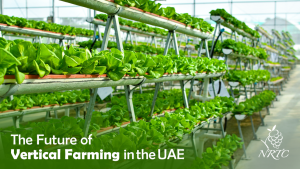
The United Arab Emirates has long been at the forefront of innovation—transforming desert landscapes into global hubs and investing in technologies that redefine possibilities. Among the most promising advancements in recent years is vertical farming, a modern agricultural method that could play a key role in ensuring the nation’s food security and sustainability.
The UAE currently imports between 80–90% of its food. This is driven by limited arable land, scarce freshwater resources, and harsh climate conditions. Traditional farming faces steep challenges in this environment. Vertical farming provides an alternative by growing crops in controlled indoor environments using hydroponics and aeroponics. These systems can produce food year-round, with up to 90% less water compared to conventional agriculture, making them particularly well-suited to the region.
The opportunities ahead are significant. Vertical farming directly supports the UAE’s Food Security Strategy 2051 by reducing reliance on imports and enhancing local production. It also represents an important frontier for innovation. Artificial intelligence, the Internet of Things, and renewable energy are being increasingly integrated into farming systems to make them more efficient and sustainable. Beyond large-scale production, vertical farms are also finding applications within cities themselves. Modular units are being installed in hotels, supermarkets, and residential communities. This urban integration not only shortens supply chains but also brings consumers closer to the source of their food. There is also potential to build an export market for premium, locally grown produce tailored to regional demand.
Nevertheless, several challenges remain. Vertical farming requires high initial investment and significant operating costs. Energy demand continues to be a concern, though greater use of renewable energy is helping to offset this. The variety of crops that can be grown in vertical farms is still somewhat limited, but ongoing research is gradually expanding the range. Just as importantly, the industry will require a skilled workforce in agritech, automation, and data-driven farming in order to scale sustainably.
Looking ahead, vertical farming is poised to become a pillar of the UAE’s food ecosystem. The country’s commitment to sustainability, combined with increasing public–private collaboration and global investment, provides a strong foundation for growth. By embracing innovation and fostering partnerships, the UAE is moving closer to creating a self-sufficient, climate-resilient ecosystem. The journey is still at an early stage, but vertical farming stands as one of the most vital steps toward a greener and more food-secure future.
#VerticalFarming #SustainableAgriculture #FoodSecurity #AgriTech #Innovation #SmartFarming #FutureOfFarming #GVF2025 #GlobalVerticalFarmingShow #NRTC #NRTCFresh #UAE

